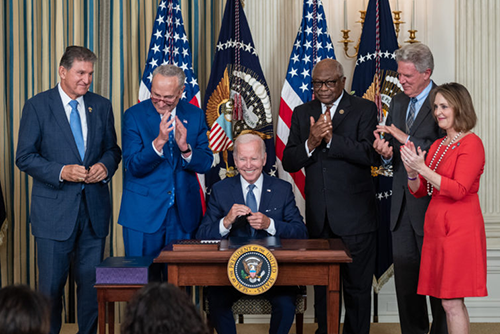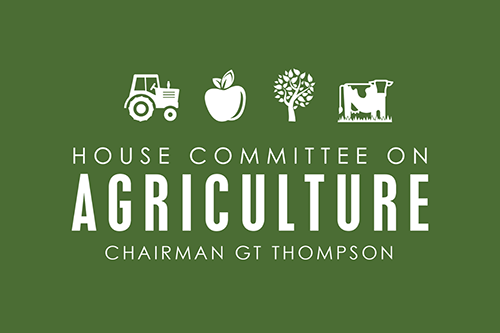
This week, we’re highlighting key provisions of the law and how leaders within the cooperative community are responding.
“This law recognizes that co-ops have a huge role to play in helping people across the country address climate change,” said Doug O’Brien, president and CEO of NCBA CLUSA.
“As a cooperative community, we now have new tools to help our members be an even greater part of the solution to one of today’s greatest challenges. Co-ops should now look at how they can work together to make the greatest positive impact possible.”
“As a cooperative community, we now have new tools to help our members be an even greater part of the solution to one of today’s greatest challenges: climate change.” – Doug O’Brien, president and CEO, NCBA CLUSA
PROVISIONS FOR ELECTRIC CO-OPS
When Senate Majority Leader Chuck Schumer (D-NY) and Sen. Joe Manchin (D-W.Va.) introduced the Inflation Reduction Act in late July, the National Rural Electric Cooperative Association (NRECA) applauded the legislation, citing its direct federal payments to electric co-ops as incentives for developing energy innovations.
“As electric co-ops continue to innovate and lead, direct access to energy innovation tax incentives is absolutely critical,” NRECA CEO Jim Matheson said in a news release. “This bill creates direct incentives for co-ops to bolster investments in carbon capture, grid modernization, renewables, battery storage and other energy technologies.”
The final legislation contains several policy provisions of interest to electric cooperatives, including some of NRECA’s top legislative priorities.
Direct Pay: Under the bill, electric cooperatives—for the first time—will have direct access to energy innovation tax credits and parity with industry counterparts when they deploy new energy technologies, including carbon capture, nuclear, energy storage and traditional renewables.
USDA Assistance for Rural Electric Cooperatives: This provision creates a voluntary $9.7 billion grant and loan program designed specifically for electric co-ops that buy or build new clean energy systems.
- Areas of Emphasis: Renewable energy, carbon capture, battery storage, nuclear power and improvements to generation and transmission efficiency.
- Loan Stipulations:
- No eligible co-op entity may receive an amount equal $970 million, or more than 10% of the total amount available
- The amount of a grant received shall be not more than 25% of the total project costs
- Loans run till September 30, 2031
Rural Energy for America Program (REAP): This program provides guaranteed loan financing and grant funding to agricultural producers and rural small businesses—including cooperatives—for renewable energy systems or to make energy efficiency improvements. Co-ops, farmers and small businesses that are part of cooperatives will have much greater access to this program in the coming years with the new resources.
- $820,250,000 for fiscal year 2022, to remain available until September 30, 2031
- $180,276,500 for each of fiscal years 2023 through 2027, to remain available until September 30, 2031
- Total of $1.72 billion through 2031 for Underutilized Renewable Energy Technologies
Department of Energy (DOE) Provisions:
- Nearly $9 billion for DOE home energy retrofits and home electrification projects
- Approximately $9 billion for loan guarantees to promote clean energy infrastructure, with additional benefits for projects on tribal lands and in disadvantaged communities
- $2 billion to finance the construction or modification of electric transmission facilities that are located within a national interest electric transmission corridor
- $40 billion renewal of section 1703 of the Energy Policy Act of 2005 for DOE to provide loan guarantees for projects that avoid, reduce, or sequester air pollutants or anthropogenic emissions of greenhouse gases
- Loans for facilities that manufacture advanced vehicles that emit either a low amount of or no amount of greenhouse gas emissions
- Loans for the domestic production of efficient hybrid, plug-in electric hybrid, plug-in electric drive, and hydrogen fuel cell electric vehicles
PROVISIONS FOR FARMER CO-OPS
Similarly, the Inflation Reduction Act casts farmers, ranchers and producers as key actors in climate action. With most of America’s 1.9 million farmers and ranchers belonging to at least one of the country’s 1,900 agricultural co-ops, the new law has significant ramifications for the ag co-op sector.
- Nearly $40 billion to tackle the climate crisis, lower costs and create good paying jobs by investing in agriculture, forestry and rural communities
- $19.5 billion in conservation funding to help farmers and ranchers address climate crisis through climate-smart agriculture. Farmer owned co-ops are primed to help scale new climate smart agriculture production practices.
- Incentivizes sustainable practices—like optimizing fertilizer use and expanding cover crops—that are a win-win for conservation and for producers’ bottom line. (Sen. Committee on Agriculture, Nutrition, and Forestry)
- $500 million for grants to increase the sale and use of agricultural commodity-based fuels through infrastructure improvements for blending, storing, supplying, or distributing biofuels.
- $5 billion for forest management, planning and restoration activities for federal and nonfederal forests.
Both the National Farmers Union (NFU) and National Council of Farmer Cooperatives (NCFC) responded to the legislation.
“The passage of the Inflation Reduction Act is cause for optimism for farmers and ranchers across the country, with historic investments in voluntary, incentive-based conservation programs that are critically underfunded,” NFU President Rob Larew said in a news release.
“NFU is proud to see investment in biofuels infrastructure that will help farmers’ bottom line and help consumers save at the pump. The inclusion of financial support for economically distressed farmers and ranchers is also a welcome addition that will help keep farmers on their land for years to come,” Larew continued.
NCFC President Chuck Conner said the law’s investment in climate-smart agriculture “represents a recognition by policymakers of the important role that America’s farmers, ranchers and growers can play in addressing the issue of climate change. It is especially important that the funding is targeted at voluntary, working-lands conservation programs that have a long, proven track record of success.”
The Inflation Reduction Act makes a number of revisions to the original American Rescue Plan Act of 2021. Section 1005 initially provided debt relief to socially disadvantaged farmers and ranchers. However, revisions in the Inflation Reduction Act alter the recipients from “socially disadvantaged” to farmers and ranchers “at financial risk,” broadening eligibility for debt relief and reducing funds available to socially disadvantaged farmers.
- $3.1 billion provided in relief to those borrowers whose agricultural operations are at financial risk as expeditiously as possible, as determined by the Secretary
- $2.2 billion for a program to provide financial assistance, including the cost of any financial assistance, to farmers, ranchers or forest landowners determined to have experienced discrimination prior to January 1, 2021 in USDA farm lending programs
- 1006: $125 million to provide outreach, mediation, financial training, capacity building training, cooperative development and agricultural credit training and support, and other technical assistance
- $250 million to provide grants and loans to eligible entities for underserved farmers, ranchers and forest landowners, including veterans; limited resource producers; beginning farmers and ranchers; and farmers, ranchers and forest landowners living in high poverty areas
- $10 million to fund the activities of one or more equity commissions that will address racial equity issues within the USDA and its programs
- $250 million to support and supplement agricultural research, education and extension
The original American Rescue Plan Act provided $4 billion in debt relief to socially disadvantaged farmers. The reduction in debt relief jeopardizes the future of Black farmers in the U.S., said Cornelius Blanding, Executive Director of the U.S. Federation of Southern Cooperatives/Land Assistance Fund. “We are in support of the IRA and its potential to improve the lives of underserved people and their communities. However, we remain concerned that Section 1005 was rescinded and the promise of debt relief for farmers of color is still uncertain.
“The apparent discrimination claims process shifts the burden of addressing racial discrimination from institution to individual and after what we learned from the Pigford, Keepseagle and Garcia settlement processes, we are deeply concerned about the difficulties Black farmers will face accessing these resources.”
Blanding concluded: “Nevertheless, we will continue to work with the Administration and USDA to ensure Black farmers, landowners and cooperatives benefit from the IRA as intended.”


